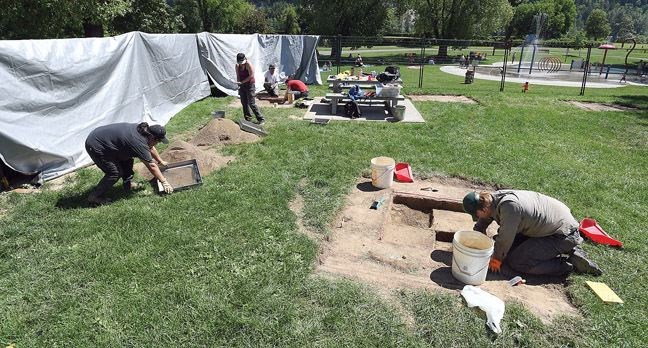Trowels and screens in hand, a team of archeologists is at work looking for artifacts where the new pavilion will be erected at Lheidli T'enneh Memorial Park.
They began the meticulous, painstaking process on Tuesday. The plan is to have their excavation of a half-dozen metre-by-metre spots wrapped up by Canada Day, with the pavilion's construction to begin after the long weekend.
"It depends on what we find," said project supervisor Normand Canuel of Norcan Consulting Ltd. "Some of these units will start going pretty quick, once we get down 30-40 centimetres and then we'll scrape them off real fast if we're not coming up with anything.
"If we're finding stone tools or what have you, it takes longer."
The findings have been slim so far - just a couple bone fragments likely from deer and some flakes from the making of a stone tool, although Canuel noted it was the first one found in the five years his team has done work in the park.
It was once home to a Hudson's Bay Company fur trading post and a Lheidli T'enneh village. Beyond that, details about its history are sparse.
Canuel said the original fort was at the junction of the Nechako and Mud (Chilako) rivers and when it was moved in the 1830s, the Lheidli T'enneh followed and established a new village to be close to the fur trade.
"But we don't have anything in the historical records that says anyone was here...parts of the documentation from the fort are missing," Canuel said.
Evidence of human activity dating back 8,000 years was found in the vicinity of Simon Fraser Bridge in 2007 when a project was commissioned as part of the twinning project. But so far, "nothing really old yet" has been found at LTM, just items dating from the 1800s.
"We've found old hand-drawn nails, we've found little medicine bottles, bone fleshers - tools used to skin hides - which might put that really early in the sense that it was right at the beginning of the fur trade before they started giving them metal tools," Canuel said.
Items of note are handed over to Exploration Place.
In 1913, the Lheidli T'enneh were effectively ousted from the site and moved to the Shelley reserve, their homes set ablaze to prevent them from returning.
The area has gone through changes since then. Noting it was home to a golf course before it was turned into a park, Canuel has found evidence from a more modern area.
"I know when we were doing work here last year, we were going along the sidewalk and coming up with manhole covers," Canuel said. "So there must have been a road but I don't remember one growing up here."



